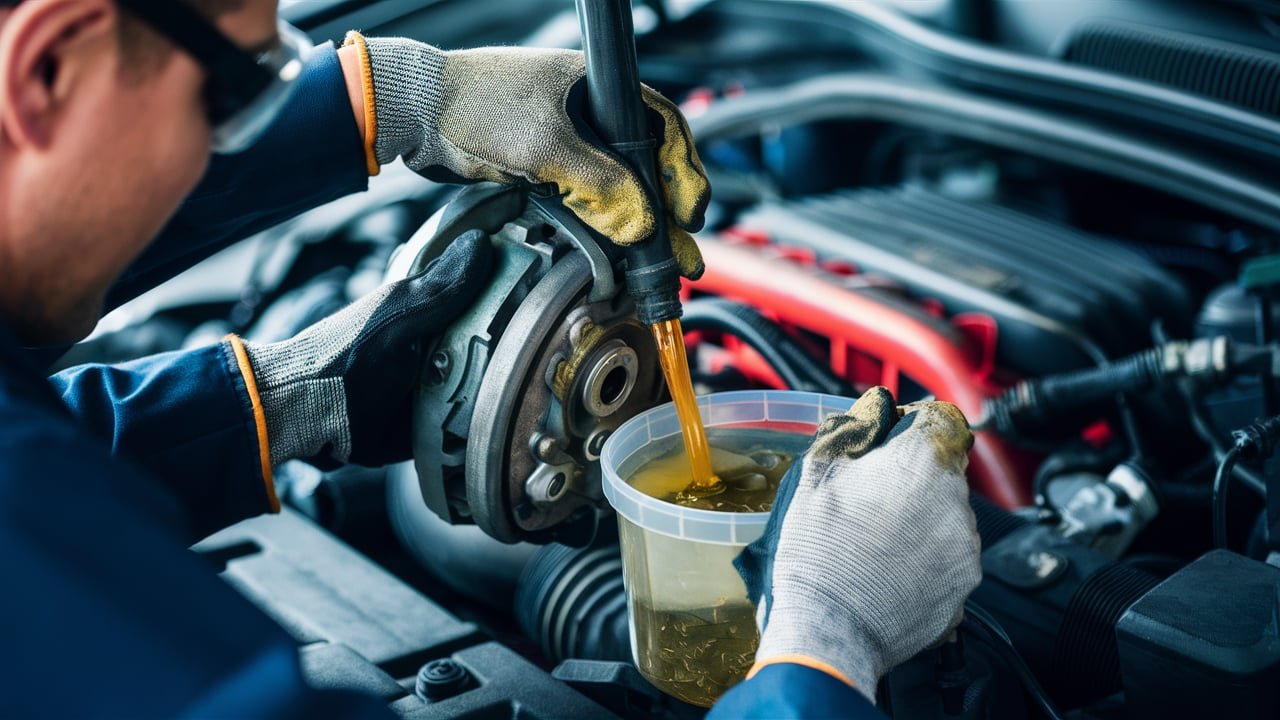
Understanding Brake Fluid Bleeding: A Comprehensive Guide
In the intricate realm of automotive maintenance, where precision holds paramount importance, a fundamental yet often underestimated procedure stands at the core of ensuring vehicular safety: brake fluid bleeding.
Entwined with the crucial task of maintaining a vehicle’s braking system integrity, brake fluid bleeding serves as a meticulous process that demands attention to detail and adherence to best practices.
Defined as the methodical removal of air bubbles and old brake fluid from the hydraulic system, this procedure safeguards against potential brake failure and guarantees optimal operational efficiency.
The stakes in overlooking or neglecting brake fluid bleeding reverberate profoundly within the realm of vehicle safety. As an indispensable component in preserving the functionality of a car’s braking capacity, proper maintenance through regular bleeding plays a pivotal role in averting potentially catastrophic outcomes.
A comprehensive understanding of this process not only ensures enhanced performance but also underscores its non-negotiable nature concerning driver and passenger well-being, alongside upholding road safety standards.
Embracing this nuanced practice embodies a proactive approach toward fortifying one’s automobile against avoidable risks and aligns resolutely with overarching principles of responsible vehicle ownership and maintenance.
What is Brake Fluid?
Brake fluid is a specialized hydraulic fluid crucial for the proper functioning of a vehicle’s braking system. Composed of glycol-ether, brake fluid serves as the medium through which force is transmitted to activate the brakes when you press the pedal.
This critical role in transmitting pressure from the master cylinder to the brake calipers or wheel cylinders emphasizes its significance in ensuring safe and effective braking performance.
There are several types of brake fluids used in vehicles, categorized based on their chemical composition and performance characteristics. The most common types include DOT 3, DOT 4, and DOT 5.1.
Each type has specific properties related to boiling point, viscosity, and compatibility with different braking systems. It is vital for car owners and mechanics to understand these distinctions when choosing the appropriate brake fluid for their vehicles to maintain optimal brake system efficiency.

Regular maintenance and testing of brake fluid quality are paramount in upholding the safety and functionality of a vehicle’s braking system. Over time, brake fluid can absorb moisture from the air, affecting its boiling point and causing corrosion within the hydraulic components.
Conducting routine tests for water content and pH levels in the fluid helps prevent potential damage to critical parts like brake lines and seals. By monitoring and replacing brake fluid at recommended intervals, car owners can uphold peak braking performance while safeguarding against premature wear or malfunction due to degraded fluid quality.
Understanding Brake Fluid Bleeding Process.
Brake fluid bleeding is a crucial maintenance procedure that involves removing air bubbles within the braking system to ensure optimal brake performance. Here is a step-by-step guide on how to effectively bleed your brake fluid:
1. **Prepare Your Vehicle:** Park your car on level ground and engage the parking brake securely. Remember to wear appropriate safety gear, including gloves and goggles, before starting the process.
2. **Locate the Bleeder Valve:** Identify the bleeder valve in each brake caliper or wheel cylinder. Attach a clear hose to the valve’s nipple and place the other end in a container filled with some fresh brake fluid.
3. **Bleeding Sequence:** Follow the recommended bleeding sequence for your specific vehicle – often starting from the furthest wheel from the master cylinder and progressing towards it, typically rear passenger side, rear driver side, front passenger side, and finally front driver side.
When undertaking this task, make sure you have essential tools and equipment ready at hand, such as a box-end wrench or line wrench to open the bleeder valves smoothly without causing damage. Additionally, using a quality brake bleeder kit can facilitate a more efficient process by creating a vacuum to draw out air bubbles effectively.
During the brake fluid bleeding process, several common mistakes should be avoided to maintain operational safety:
– Overfilling or underfilling the master cylinder reservoir
– Allowing air to re-enter during bleeding
– Using improper techniques leading to stripped bleeders or damaged components
By adhering to proper techniques and ensuring no shortcuts are taken when bleeding brake fluid, you can significantly enhance your vehicle’s braking system efficiency while maintaining safety standards for both yourself and others on the road.
Signs Your Vehicle Needs Brake Fluid Bleeding.
Recognizing the signs that indicate your vehicle requires brake fluid bleeding is crucial for maintaining optimal braking performance and safety on the road. One of the most common symptoms signaling this need is spongy brakes.
If you press the brake pedal and notice it feels soft or goes all the way to the floor before engaging fully, it could be a sign of air bubbles or contaminants in the brake fluid. Another red flag is decreased responsiveness when applying the brakes; if you experience delays in braking or have to press harder than usual to stop your vehicle, it’s time to consider bleeding the brake system.
It is essential to address these signs early on to prevent potential accidents or damage. Ignoring spongy brakes or reduced responsiveness can compromise your ability to stop safely, increasing the risk of collisions or loss of control while driving.
Regularly inspecting and maintaining your vehicle’s braking system ensures that it operates at its best when you need it most. Additionally, staying proactive about addressing issues like spongy brakes can help prevent more severe problems down the line, saving you both time and money on extensive repairs.

The frequency with which you should bleed your brake fluid depends on various factors such as your vehicle’s make and model, driving habits, and environmental conditions. As a general guideline, experts recommend bleeding brake fluid every one to two years for most vehicles under normal driving conditions.
However, if you frequently drive in challenging environments like heavy traffic or mountainous regions where brakes are used more intensively, you may need more frequent maintenance. Checking your vehicle’s manual or consulting a professional mechanic can provide tailored recommendations based on your specific circumstances to ensure optimal braking system performance and safety.
Benefits of Proper Brake Fluid Maintenance.
Proper maintenance of brake fluid serves as a cornerstone for ensuring enhanced performance and longevity of the brake system in vehicles. By adhering to recommended flushing schedules, car owners can mitigate issues such as brake fade or loss of braking pressure, which can compromise overall vehicle safety.
For example, neglected brake fluid may accumulate moisture over time from exposure to air, leading to diminished boiling points that could result in vapor lock during heavy braking scenarios. Preventive measures like regular bleeding and fluid replacement not only help maintain the hydraulic integrity of the brake system but also contribute to smoother and more responsive braking actions.
Regularly changing brake fluid plays a pivotal role in preventing corrosion and rust within vital braking components like the master cylinder, calipers, and brake lines. Brake fluid, due to its hygroscopic nature—ability to absorb moisture from the atmosphere—can become contaminated with water over time.

Water contamination within the braking system can accelerate corrosive processes on metal parts, potentially leading to leaks or decreased efficiency. By replacing old brake fluid at recommended intervals, vehicle owners shield their brake apparatuses from premature wear and tear caused by internal rusting or pitting.
This proactive approach not only safeguards crucial braking infrastructure but also contributes significantly to maintaining optimal safety standards on the road for both drivers and passengers.
Furthermore, proper maintenance of brake fluid ensures optimal safety for all road users by preserving effective braking functionality under varying driving conditions. Since brakes are fundamental in averting potential collisions or emergencies when maneuvering through traffic or unforeseen obstacles, having well-maintained brake fluid directly translates into reliable stopping power when needed most.
In emergency situations where split-second decisions could mean the difference between safety and calamity, properly maintained brakes instill confidence in drivers’ ability to control their vehicles effectively.
Thus, investing time and resources into regular inspections and servicing of brake fluids is a prudent choice towards upholding road safety standards while maximizing the lifespan of critical components within any vehicle’s braking system.
DIY vs. Professional Brake Fluid Bleeding Services.
When it comes to deciding between performing brake fluid bleeding at home or seeking professional services, several factors influence the choice. Home mechanics who are well-versed in automotive maintenance may opt for a DIY approach to save on service costs and gain a deeper understanding of their vehicle’s braking system.
However, expertise plays a crucial role in ensuring the process is executed correctly. A minor mistake during brake fluid bleeding can compromise the safety of the entire braking system. Professionals trained in this task can provide assurance that the job is done accurately and efficiently.
Another consideration is equipment availability. Bleeding brake fluid requires specific tools like a brake bleeder kit and jack stands to elevate the vehicle safely. Not all DIY enthusiasts may have access to these specialized tools, making professional services a more practical choice.

Time commitment is also significant; while performing brake fluid bleeding at home allows for flexibility, it requires careful attention to detail and can be time-consuming compared to quick service from professionals with ample experience.
Cost considerations are essential when weighing DIY against professional services. While performing tasks independently can save money on labor costs, investing in quality equipment and ensuring the correct type of brake fluid can add up. In contrast, opting for a professional service may involve higher upfront expenses but guarantees efficient execution without risks associated with potential errors during DIY work.
Understanding personal skill levels, available resources, time constraints, and budgetary limitations are crucial aspects to consider when choosing between DIY and professional brake fluid bleeding services.
Common Questions About Brake Fluid Bleeding.
As car enthusiasts or DIY mechanics embark on the task of brake fluid bleeding, they often encounter common questions that can impact the effectiveness and safety of the procedure. One frequent query revolves around the timing of brake fluid bleeding.
Best practices in automotive maintenance suggest that brake fluid should ideally be bled every 1-2 years to ensure optimal brake system performance. However, in cases where a vehicle undergoes intense driving conditions or experiences symptoms like spongy brakes, more frequent bleeding may be necessary to maintain safety standards.
Another important concern is mixing different types of brake fluids during the bleeding process. Mixing incompatible fluids can lead to chemical reactions that compromise braking performance and cause damage to system components.

It is crucial always to refer to the manufacturer’s recommendations for the correct type of brake fluid for your vehicle and avoid mixing different types unless specifically instructed otherwise. When in doubt, it is advisable to consult a professional mechanic who can provide expert guidance tailored to your specific vehicle model.
During the process of brake fluid bleeding, encountering issues such as air bubbles in the system can impede its effectiveness. To troubleshoot this common problem, thoroughly inspect all connections and fittings for leaks or loose seals that may allow air ingress.
Additionally, ensuring proper pressure application while bleeding by following precise steps can minimize air entrapment in the brake lines. By preemptively addressing potential issues like air bubbles, DIYers and mechanics can enhance the efficiency of their brake fluid bleeding efforts and uphold high safety standards on the road.
Conclusion: Importance of Regularly Bleeding Brake Fluid.
In conclusion, this comprehensive guide on brake fluid bleeding has delved into the critical importance of this maintenance task for ensuring optimal vehicle safety and performance.
By understanding the components and purpose of brake fluid, recognizing the signs that indicate the need for bleeding, following a systematic bleeding process, and maintaining quality through proper testing, car owners and mechanics alike can uphold the integrity of their braking systems.
Regularly bleeding brake fluid not only enhances brake system performance and longevity but also protects against corrosion within vital braking components. It stands as a fundamental practice in automotive maintenance to guarantee effective brakes that contribute significantly to driver safety.
It is imperative for individuals interested in DIY auto maintenance, mechanics, and automotive enthusiasts to prioritize regular checks and maintenance regarding their vehicles’ braking systems.
Diligent attention to bleeding brake fluid at appropriate intervals sustains vehicle safety standards, prevents accidents due to faulty brakes, and extends the lifespan of critical braking system components.
As this guide has outlined in precise detail, operating a vehicle with well-maintained brakes not only ensures safe travels for the driver and passengers but also contributes positively to road safety overall.
By adhering to recommended practices and staying proactive about brake fluid maintenance, all stakeholders can enjoy the benefits of reliable braking systems while safeguarding themselves against potential risks on the road.




